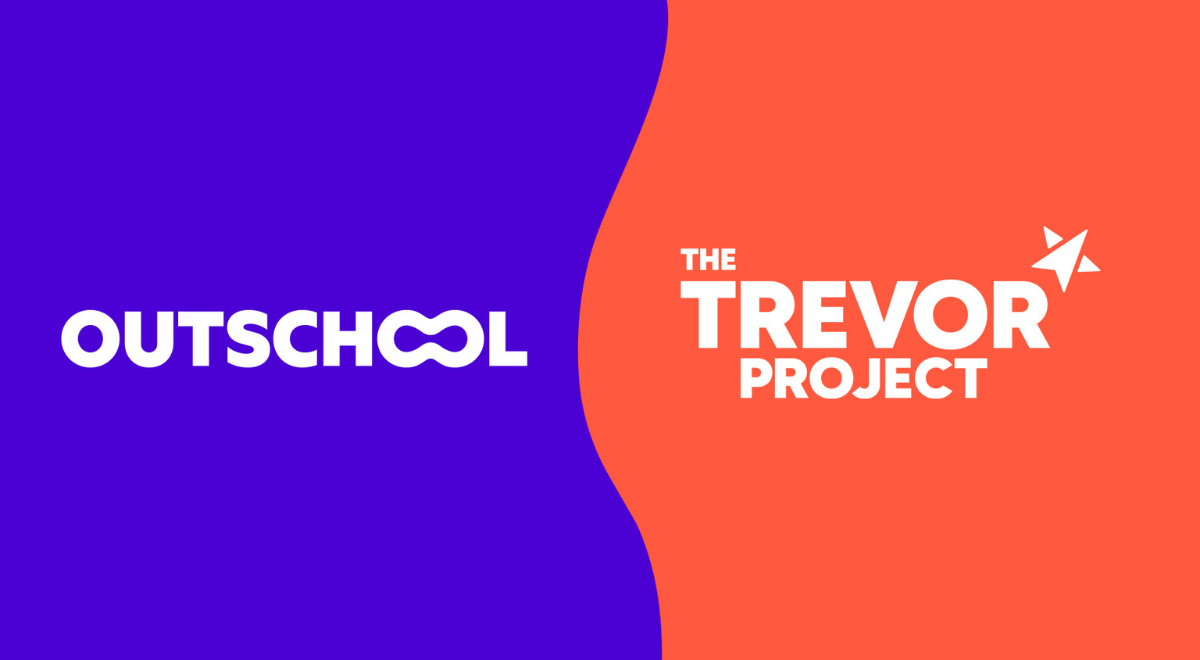Attention: This article discusses suicide, specifically in relation to LGBTQ+ youth.
In November 2022, the Outschool community was excited to welcome Penelope French, Public Training Manager for The Trevor Project, as she hosted a 2-hour interactive session on how to support LGBTQ+ youth at Outschool.
The Trevor Project is the world’s largest suicide prevention and mental health organization for LGBTQ+ young people. In this webinar, educators on Outschool learned more about what it means to be a true ally to all learners who enter the classroom and how to create an inclusive environment where LGBTQ+ kids and teens feel safe and supported.
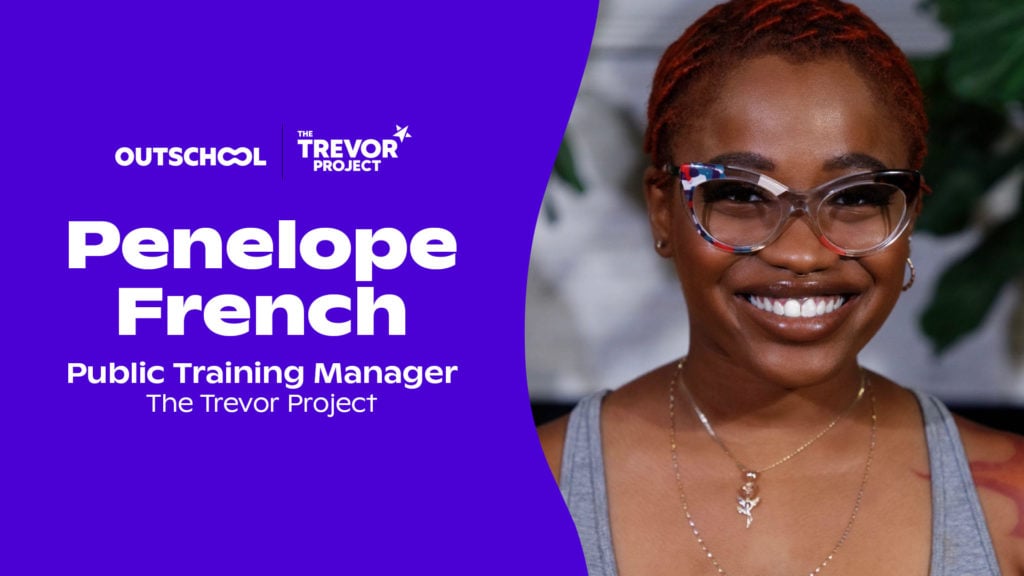
While no webinar recording is available to protect the privacy of those who attended, here are a few highlights in case you missed it:
Why are we talking about supporting LGBTQ+ youth?
While suicide is tough to talk about, we can only put in place the right resources and systems to mitigate suicide in our communities when we acknowledge and confront it.
As of 2022, suicide is the 10th leading cause of death for all ages in the U.S., but the 2nd leading cause of death among LGBTQ+ youth ages 10-24. Approximately 1.8 million LGBTQ+ youth seriously consider suicide each year—and we believe that’s 1.8 million too many.
What role can educators play in lowering this number? The Trevor Project shared that LGBTQ+ youth are at a 40% lower risk of dying by suicide when they have at least one accepting adult in their lives. On Outschool, we also want to recognize that creating an inclusive community in your classrooms provides all learners with a place where they can feel that they belong, make real friendships that enrich their lives, and find support when they need it.
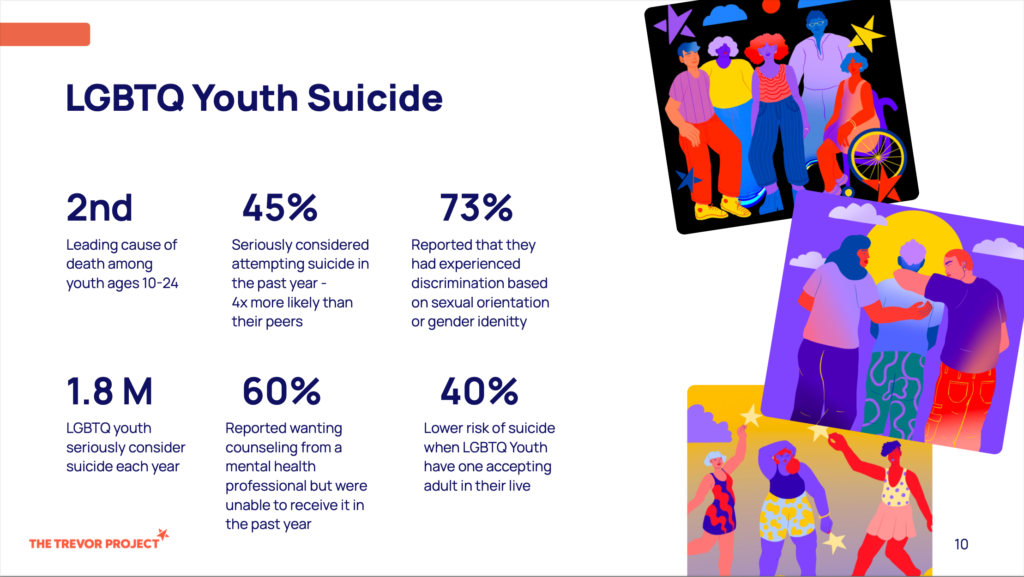
Just one person can make an enormous impact not only for LGBTQ+ youth but for any kid searching for a sense of belonging and support.
And building that inclusive space on Outschool starts with you. You can be the ally a learner needs to have the confidence to choose to live.
What is allyship?
LGBTQ+ youth need and deserve a community that respects, support, and protects them, and taking an active role in that community is how you can become an ally.
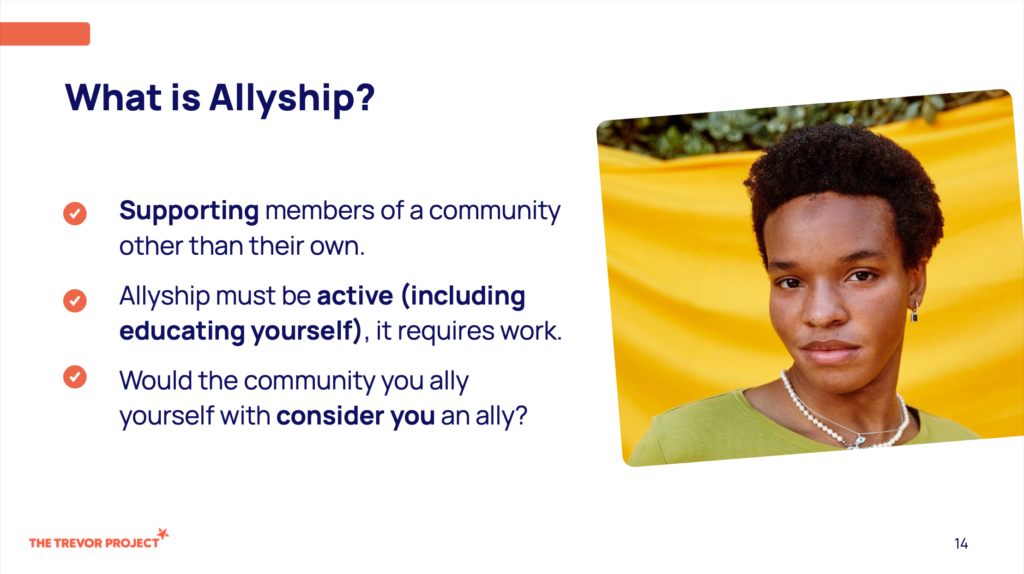
First and foremost, being an ally is an active pursuit, and it requires work. It’s a case of “talking the talk and walking the walk.” Change only happens when we take action.
Penelope says,
“We will never be able to know someone as well as they know themselves. What we can do is get to know the community on a deeper level. Would the community I think I’m an ally with think that I’m an ally? Do they know who I am, do they know I’m here to help? Am I active in my allyship and showing up all the time? Or do I only show up when it’s convenient or for show? Be honest.”
If the answer is “no, they wouldn’t think I’m an ally” or “I’m not sure if they know I’m an ally,” then it’s time to think about what more you could do to let people know that you’re in their corner.
Some educators mentioned that they intentionally write in their classroom or share verbally that everyone, no matter their identity or background, is welcome in their class.
A few more ways you can be an ally to LGBTQ+ kids and teens in class are:
- Offer your pronouns when introducing yourself to set an example that it’s okay for kids to share their pronouns and preferred name. This can be as simple as, “Hi, I’m Mr. Nate and you can use he or they when talking about me. Could everyone else let us know what we should call you in class?”
- Include your commitment to inclusion in your class descriptions. For example, “I welcome learners of all identities and backgrounds into my classes.”
- Maintain Outschool’s Community Standards by quickly addressing, managing, and/or reporting (when appropriate) any behavior in class that is not welcoming or inclusive of LGBTQ+ identities.
- Dedicate yourself to choosing classroom materials and resources that include multiple perspectives, including those of people who identify as LGBTQ+.
- Ask questions in class that encourage learners to share and welcome others’ thoughts, ideas, and experiences.
Penelope reminds us,
“Allyship matters because community matters… Being connected matters because how we all see one another matters. And so we have to put our focus back on our connection as humanity and celebrate our differences. And…those differences help us be the magnificent people that we are.”
What’s the deal with pronouns, and how do I handle them in class?
Gender pronouns are the words we use to refer to someone that we’re talking about. She loves to go surfing. He brought his pet rabbit to class. They forgot their homework. Ze is really into video games.
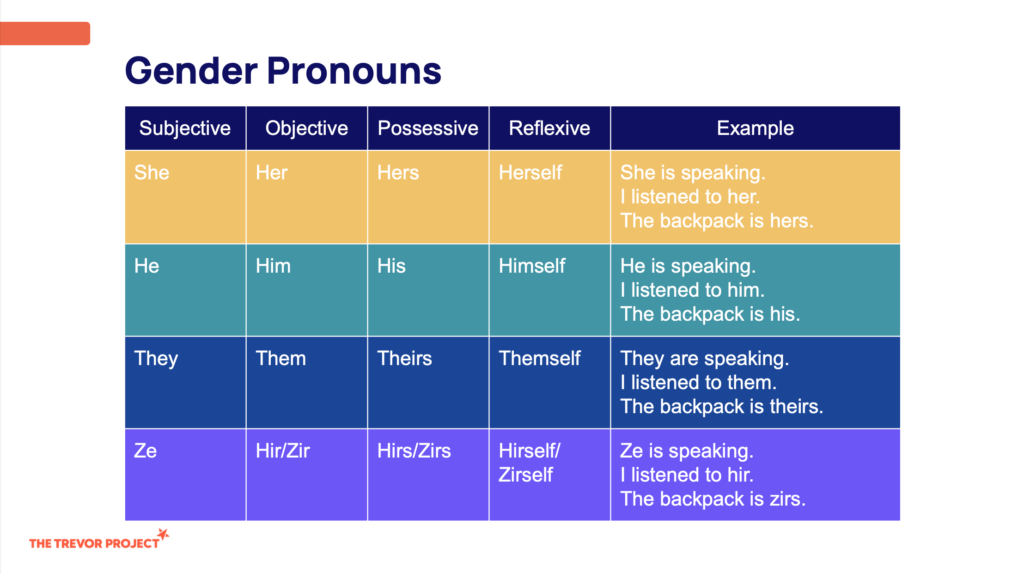
See pronunciation guidelines for ze/zir/hir.
We use them every day, and for most of history people have just assumed the preferred pronouns of whomever they’re speaking about. Or, people have felt pressured to use certain pronouns because of societal expectations or fear of judgment (or worse). Acknowledging, sharing, and asking about pronouns helps all learners feel welcome and included.
Pronoun myth #1: It’s impolite to ask for someone’s pronouns
The opposite is true; asking for someone’s pronouns is always okay! Just as you would ask for someone’s name, so you don’t just have to refer to them as “hey you,” asking for pronouns gives a person the chance to tell you how they were like to be referred to.
You should never assume someone’s pronouns, just like you wouldn’t meet someone and think: “Yeah, they look like a Diana. I’m gonna call them Diana,” instead of asking what their name is.
Some educators in this session shared that they always introduce themselves along with their pronouns, then ask their learners to introduce themselves. This sets an example of encouraging learners to share their names and pronouns, but it doesn’t put anyone on the spot. Example: “Hello, I’m Ms. Zara, and my pronouns are she or her. That means you can use she or her when talking about me. What should I call you in class?”
You can also include your pronouns in your Zoom name or educator profile, so families know how to refer to you right from the beginning.
All educators should feel empowered to let learners take the lead when it comes to their preferred pronouns or even name. Some kids may want to go by a different name in class, one that they identify with more than the name on their Outschool profile, and that’s okay, too!
Pronoun myth #2: If I mess up, I’m a horrible person
There may be times when you forget someone’s pronouns. Mistakes happen. What matters is that you are committed to correcting your mistakes, and making an effort to remember a person’s pronouns.
If you happen to make an assumption or mistake and are corrected or notice your error, apologize and move on.
Turning a pronoun mix-up into a big deal with extended apologies or a big discussion about your mistake draws unnecessary attention and may unintentionally run the risk of forcing someone to come out who isn’t ready.
Here’s an example of what that swift correction may sound like: “She—sorry, I mean they—have brought something for show and tell. Let’s give them our attention.” Here we see the speaker apologized, corrected themselves in the next sentence, and moved on. Quickly and confidently moving forward after making a mistake shows the person that you are making an effort to use their correct pronouns and normalize the process.
Pronoun myth #3: Using “they” to refer to someone isn’t proper English
English speakers commonly (and correctly) use they/them to refer to a person when their gender pronouns are unknown.
For example, say you’re in a store and you see a lost wallet on the ground. You may say something like, “Oh no, someone’s lost their wallet. I hope they get their wallet back.” You would most likely not say, “I hope he or she gets his or her wallet back.”
So, myth busted: “They” can and often does refer to a singular person. They/them is your best choice when you don’t know someone’s pronouns since we already commonly use these pronouns in that way, and it is absolutely the right choice if a person indicates that they identify with they/them.
When people use this argument to object to using a pronoun, what they’re often feeling is discomfort with something that’s new or that they don’t fully understand. By normalizing the sharing of pronouns and correctly using they/them pronouns when asked, you can help ease the transition from being uncomfortable to accepting.
Common LGBTQ+ language
Let’s wrap up by going over some common terms related to LGBTQ+ identities. Knowing what each of these words means can help you better handle conversations around identity in your classrooms and beyond.
Gender
A socially constructed identity centering around notions of “masculinity,” “femininity,” and “androgyny,” which includes aspects of identity and expression.
Gender identity
Someone’s innermost concept of self as masculine, feminine, a blend of both, another gender or set of genders, or lack of gender. This is not always congruent with their sex assigned at birth or their gender assigned at birth.
Gender expression or Expression
The ways in which a person presents themself to the world through hairstyles, clothing, toys, preferences, mannerisms, or other things.
Sexual orientation
Commonly defined as patterns of emotional, romantic, and/or sexual attractions to another person or people.
Gay
Commonly used to describe an individual who identifies as a man whose attractions are to some other men. This word has previously been used as an umbrella term for all LGBTQ people, but the more inclusive term is now the “LGBTQ” or “queer” community.
Lesbian
Commonly used to describe someone who identifies as a woman, whose attractions are to some other women.
Bisexual/Pansexual
Used to describe an individual who is attracted to more than one gender. Individuals who identify as this need not have had equal sexual experience with people of multiple genders; in fact, they need not have had any sexual experience at all to identify as this. Historically framed as being attracted to “both” genders, this has been reframed to include people who fall outside the gender binary.
Asexual/Ace
Used to describe someone who experiences little or no sexual attraction. While most people who identify this way desire emotionally intimate relationships, they are not drawn to sex as a way to express that intimacy.
Questioning
Refers to someone who is in the process of discovering or exploring their sexual orientation or gender identity, and who has not claimed a precise identity to use to describe these characteristics.
Queer
Umbrella term used to describe someone who is a sexual or gender minority (generally, not heterosexual and/or cisgender). This word has historically been used as a slur against LGBTQ people, but it has been increasingly reclaimed by LGBTQ communities and is now used by and among some people who are LGBTQ. Note that many folks are still not comfortable using this word or being referred to as this word so it’s best to mirror language while using this term.
Transgender (Trans)
A term that describes someone whose gender identity differs from the gender they were assigned at birth.
Cisgender
A term for people whose gender identity matches the sex or gender they were assigned at birth. This is commonly referred to as the opposite of “transgender,” and was created by transgender people who felt that by not having a word to describe non-transgender people, it further “othered” the transgender community as non-normal.
Genderqueer/Nonbinary
A term used to describe one’s gender identity as not fitting into a binary (man/woman) understanding of gender. People who identify as this may express androgyny, gender neutrality, or reject identifying their gender entirely.
Intersex
An umbrella term used to describe someone born with internal and/or external sexual anatomy that doesn’t fit the typical expectations of the male/female binary.
Coming out
The process through which someone shares an identity, including their sexual orientation or gender identity, with themselves or others.
You should never share that someone has come out to you unless they expressly tell you that you can. Coming out is a process, and people come out to some people and not others for many, many reasons.
As an educator on Outschool, we hope you feel empowered to lead an inclusive classroom community that support LGBTQ+ learners. To continue your learning, explore these ACE Framework learning opportunities.
